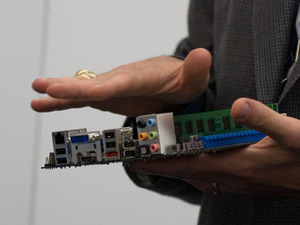
IDF Day 3 - 32nm Westmere Performance
Manufacturer: IntelIntel will launch its first 32nm processors later this year and, to break tradition, the first CPUs based on the new process won't be a new flagship chip in Extreme Edition guise. In the past, a new process has brought a combination of never-before-seen performance at a high asking price, but things are different with 32nm.
The chip giant's first 32nm CPUs based on the Westmere architecture introduce something else that's never been seen before, as they're the first processors to integrate the GPU onto the same packaging as the CPU. It's not a seamless integration though, as there are two pieces of silicon on a Clarkdale or Arrandale die - the 32nm CPU cores are on one piece of silicon, while the second is built on the older 45nm process and contains the memory controller, PCI-Express lanes and integrated graphics core.
During IDF, Intel gave us the opportunity to preview the performance of both Clarkdale and Arrandale during a briefing on Windows 7. This is something that Intel does every time a new operating system or service pack comes out and a lot of the information can end up being fairly helpful when it comes to building benchmark systems that deliver repeatable results.

The motherboard in the test system we saw. It's a mini-ITX LGA1156 board with dual-channel DDR3-1333 support and a PCI-Express x16 slot
Clarkdale is the processor that we're going to be focusing most of our time on today, because that's the desktop chip, whereas Arrandale is targeted at laptops. What we can say about Arrandale is that you can expect to see some interesting designs when it arrives, because it's going to be more power efficient than Clarkdale which itself is pretty impressive - we'll come to that in due course.
Before we get onto Clarkdale's performance though, it's worth talking about how Intel has worked with Microsoft to make the best use of its Westmere architecture in Windows 7. The two companies have worked together to improve both performance with a feature known as Idle Core.
This works quite simply, but Intel says the results are very promising. In Windows Vista, Microsoft didn't check to see whether the thread was a physical one or a virtual one, but with Windows 7, the scheduler is able to determine that. In Windows 7, the operating system scheduler checks to see if there's an idle core available (instead of just looking for the first idle thread) and if so, it assigns the new thread to that core.
If there isn't an idle core available, the thread will be assigned to one of the virtual Hyper-Threaded cores as it would have done in Windows Vista. It doesn't stop there though, as the OS scheduler uses time-slicing (known as Quantum End) to reassign an existing thread to an idle physical core if there wasn't one when the operation first started, helping to increase performance and get the task finished quicker.
When you combine Idle Core and Quantum End with SMT parking, you've got a recipe for better power consumption, as parts of the chip are powered down when they aren't required. SMT parking works by 'parking' the HT cores until the physical cores are busy enough for the HT cores to be needed. Intel also talked about Core parking as well, but that only relates to server CPUs.

MSI MPG Velox 100R Chassis Review
October 14 2021 | 15:04










Want to comment? Please log in.